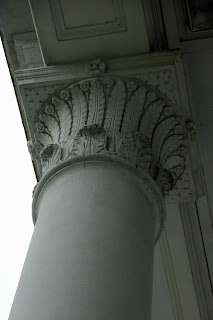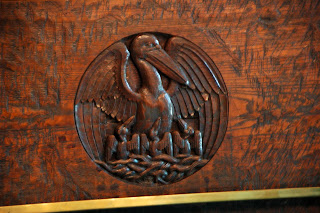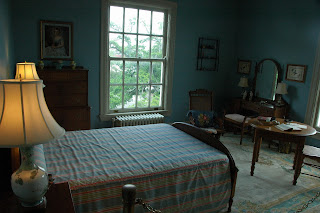I wasn't satisfied that I'd given Mississippi enough attention on my drive along the gulf coast, so I decided to head up the Mississippi River to explore it some more. I was already interested in checking out Natchez, which is part of what interested me about the steamboat Natchez I rode in New Orleans. Additionally, the only scenic drive in the book for Mississippi is Scenic Rte#114 along the Natchez Trace Parkway, which originates in Natchez, so it was decided - after completing Scenic Rte#79 through the Louisiana bayou, I would head up river to Natchez before continuing west.
Of course, Scenic Rte#79 ended at Lafayette, so I had to back track and drive northeast to get to Natchez, so I decided to take a route through the Louisiana capital city of Baton Rouge.
As I wrote in the previous day's description of how the Tabasco company uses batons rouges to ensure their peppers are ripe, but as much as the Tabasco company might want the name of their state capital to be named after their techniques, the name of the capital dates to 1699 explorers, and a more grisly sight that made a particular Red Cypress tree redder than the others around it.
The Louisiana State Capitol building is the tallest capitol in the US, standing 450 feet with 34 floors. It's also the tallest building in Baton Rouge, which made it easy to navigate to. It is situated near the Mississippi River shore, along with several other state buildings, including a former military barracks in a pentagon arrangement, the Louisiana State Museum, the Old Arsenal Museum, and others.
Old Arsenal Museum
I walked past the Capitol to the Old Arsenal Museum, taking pictures of it and the park surrounding it (most of which were over exposed, as I forgot to adjust my camera from the night before). Fortunately, I noticed in time to make an adjustment, so I didn't shoot a whole day's worth of junk pictures.
 The Old Arsenal is a small, free museum inside of an arsenal building that was built in 1838 to house the powder and munitions for the federal military fort that was posted there to secure the Mississippi River. Inside are some displays about the Battle of Baton Rouge, and the history of the capitol grounds. Some of the graffiti left by soldiers still adorns the walls.
The Old Arsenal is a small, free museum inside of an arsenal building that was built in 1838 to house the powder and munitions for the federal military fort that was posted there to secure the Mississippi River. Inside are some displays about the Battle of Baton Rouge, and the history of the capitol grounds. Some of the graffiti left by soldiers still adorns the walls.


 Outside of the Arsenal are a pair of cannon and an exact copy of the Liberty Bell. This is also provides a nice overlook of the expansive ExxonMobile oil refinery (the second largest in the country) on the north end of the city.
Outside of the Arsenal are a pair of cannon and an exact copy of the Liberty Bell. This is also provides a nice overlook of the expansive ExxonMobile oil refinery (the second largest in the country) on the north end of the city. After visiting the arsenal, I walked back toward the front of the Capitol building. As I walked up the steps to the door, I noticed that in the center of each step was the name of a state. In fact, the bottom 13 are the original 13 states, and the remaining 37 are on 3 additional sets of stairs. The steps are flanked by sculptures on either side, and relief carving marks the five story doorway.
After visiting the arsenal, I walked back toward the front of the Capitol building. As I walked up the steps to the door, I noticed that in the center of each step was the name of a state. In fact, the bottom 13 are the original 13 states, and the remaining 37 are on 3 additional sets of stairs. The steps are flanked by sculptures on either side, and relief carving marks the five story doorway. Walking through the doors, the interior shows itself to be just as grandiose as the exterior. A 10 foot bronze map of Louisiana rests at the center of the polished lava floor, sculptures of important figures in the state's history line the walls, and murals celebrating the native cultures greet you as you head toward either legislative chamber of the government, on either side of the hall.
Walking through the doors, the interior shows itself to be just as grandiose as the exterior. A 10 foot bronze map of Louisiana rests at the center of the polished lava floor, sculptures of important figures in the state's history line the walls, and murals celebrating the native cultures greet you as you head toward either legislative chamber of the government, on either side of the hall.I explored the Senate and the House chambers, including the galleries, then walked around the hallways, where I found a placard memorializing Huey Long, who championed the construction of the Capitol building during his governorship, and was subsequently assassinated in that hallway when he was a U.S. Senator.
 I went up to the 27th floor's Tower Observation Deck to take in the surroundings. I was also able to check on my car, parked in a lot across the street from the old barracks buildings.
I went up to the 27th floor's Tower Observation Deck to take in the surroundings. I was also able to check on my car, parked in a lot across the street from the old barracks buildings. On the way back to the first floor, I decided to stop off on the second floor to view the entrance hall from above, which afforded nice views of the chandeliers, ceiling, and the 12 flags that represent each of the countries that have held claim to Louisiana.
On the way back to the first floor, I decided to stop off on the second floor to view the entrance hall from above, which afforded nice views of the chandeliers, ceiling, and the 12 flags that represent each of the countries that have held claim to Louisiana. After leaving the Capitol, I decided to walk through the gardens in front of it, making my way to the center, where the remains of Huey Long are interred, marked by a monument topped with a statue of him facing the Capitol.
After leaving the Capitol, I decided to walk through the gardens in front of it, making my way to the center, where the remains of Huey Long are interred, marked by a monument topped with a statue of him facing the Capitol.Old Governor's Mansion
Before leaving Baton Rouge, I decide to also check out the Old Governor's Mansion.
 Unlike the Capitol building, the Old Governor's Mansion is run by a historical foundation, so it does charge for it's tours, but it was well worth the minor cost for a private tour by a very knowledgeable docent. The Capitol isn't the only building that was constructed under Huey Long's administration (actually, he did a lot of infrastructure work during the Great Depression years that he served). When he was elected governor, he deemed the the original governor's house unfit, so he planned the new mansion, based on the White House.
Unlike the Capitol building, the Old Governor's Mansion is run by a historical foundation, so it does charge for it's tours, but it was well worth the minor cost for a private tour by a very knowledgeable docent. The Capitol isn't the only building that was constructed under Huey Long's administration (actually, he did a lot of infrastructure work during the Great Depression years that he served). When he was elected governor, he deemed the the original governor's house unfit, so he planned the new mansion, based on the White House. Rounding out the lower floor is the kitchen, including an informal dining area with access to an adjoining patio through french doors, the Governor's office, and a library complete with a cypress mantle fireplace carved with the state seal.
Rounding out the lower floor is the kitchen, including an informal dining area with access to an adjoining patio through french doors, the Governor's office, and a library complete with a cypress mantle fireplace carved with the state seal.This Governor's Mansion served 9 Governors, including Jimmie Davis, known as the Singing Governor, who is in the Country Music Hall of Fame and is best known for singing "You Are My Sunshine." Jimmie owned a horse named Sunshine, and his saddle is among the personal effects that has been donated to the museum, most of which are displayed in the upstairs bedrooms and living quarters.
Though I was thoroughly enjoying the anecdotes the docent told me about the 9 Governors who'd resided in the mansion, I was relieved when another guest came in for a tour, and I was finally forced to wrap mine up and continue up the road to Natchez.
Natchez Arrival
When I got to Natchez, I went straight to the Visitor's Center, where I found out that they were still in their Spring Pilgrimage of Antebellum Homes, a month-long event where 29 historic homes, many of which are private residences, open their doors to visitors. I wanted to visit a few of them, so I bought a few tickets for them, and since they were all closed for the day, I also bought a ticket for the Natchez Tableaux. Another thing I found out about Natchez is that it's not pronounced Nat-chez, but, being in Mississippi, it is pronounced Na-ch-is.
Nikki's Restaurant
After driving across the Mississippi River to set up my tent at a campground on the Louisiana riverbank, I grabbed a bite of dinner at a local restaurant called Nikki's that was recommended by the operator of the RV park. Nikki's serves typical diner food, which unfortunately wasn't particularly memorable.
Natchez Tableaux
 The Natchez Tableaux is advertised as "a brilliant and entertaining depiction of the Antebellum Era through song, dance and historical dialog including adornment of period costumes." I'm usually happy to watch a performance, and enjoy history, so I figured it might be a fun event. Overall, it was entertaining, but I couldn't help but feel that it was a waste of money. I expected much more based on shows I've seen at local community theatres, and couldn't shake the feeling that I'd paid to see a high school play.
The Natchez Tableaux is advertised as "a brilliant and entertaining depiction of the Antebellum Era through song, dance and historical dialog including adornment of period costumes." I'm usually happy to watch a performance, and enjoy history, so I figured it might be a fun event. Overall, it was entertaining, but I couldn't help but feel that it was a waste of money. I expected much more based on shows I've seen at local community theatres, and couldn't shake the feeling that I'd paid to see a high school play.Don't get me wrong, the performance did fulfill all of it's promises, save one. It did feature song, dance, historical dialog, and period costumes. I just didn't find it brilliant.
Under-the-Hill
Under-the-Hill is a part of Natchez that is quite literally under a hill. It is an area on the river side under a steep bluff that served as a wharf district, mostly filled with bars, which was notorious for it's frequent violence perpetrated by lawless ruffians, making a literal Upper and Lower class. Today, it consists mostly of restaurants and bars, and though I wasn't hungry, after a mediocre dinner and entertainment, I wanted to salvage the evening by exploring a little bit of it before going back to my tent. Ending the night with a walk along the river was the perfect way to redeem an otherwise disappointing evening.
















































































































No comments:
Post a Comment